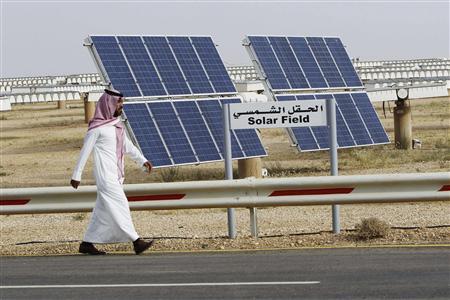Saudi Arabia is not customarily a place associatd with green energy and women’s rights, but a rich country that wants to stay that way needs to adapt. Two excerpts from articles about the nation transforming in at least some ways: Jeffrey Ball’s Atlantic piece “Why the Saudis Are Going Solar” and Juliane von Mittelstaedt and Samiha Shafy’s Spiegel feature “Lifting the Veil.”
____________________________
From Ball:
The Saudis burn about a quarter of the oil they produce—and their domestic consumption has been rising at an alarming 7 percent a year, nearly three times the rate of population growth. According to a widely read December 2011 report by Chatham House, a British think tank, if this trend continues, domestic consumption could eat into Saudi oil exports by 2021 and render the kingdom a net oil importer by 2038.
That outcome would be cataclysmic for Saudi Arabia. The kingdom’s political stability has long rested on the “ruling bargain,” whereby the royal family provides citizens, who pay no personal income taxes, with extensive social services funded by oil exports. Left unchecked, domestic consumption could also limit the nation’s ability to moderate global oil prices through its swing reserve—the extra petroleum it can pump to meet spikes in global demand. If Saudi rulers want to maintain control at home and preserve their power on the world stage, they must find a way to use less oil.
Solar, they have decided, is an obvious alternative. In addition to having some of the world’s richest oil fields, Saudi Arabia also has some of the world’s most intense sunlight. (On a map showing levels of solar radiation, with the sunniest areas colored deep red, the kingdom is as blood-red as a raw steak.) Saudi Arabia also has vast expanses of open desert seemingly tailor-made for solar-panel arrays.•
____________________________
From Von Mittelstaedt and Samiha Shafy:
In 2012, Saudi Arabia began enforcing a law that allows only females to work in lingerie stores. Gradually, women were also granted the right to sell abayas, make-up, handbags and shoes. Children’s toys. Clothes. Slowly but surely, men were banished from these realms.
Female participation in the workforce, however, brought with it a host of new problems. How could women get to work, when they’re not allowed to drive? Who was going to look after their children? What happens if they’re expecting? More laws have subsequently been passed, from a right to ten-weeks of paid parental leave, to a right to work part-time and a right to childcare support. A revolution started by lingerie. Only in Saudi Arabia.
Society has undergone dramatic change in the last ten years, ever since the late King Abdullah succeeded to the throne in 2005. The change has been especially dramatic since 2011. The main reason for the transformation is that a growing number of women are now working, and not just as civil servants, teachers and doctors. They’re increasingly better-educated and financially independent and above all, they’re a far more visible presence. They’re leaving the isolation of their homes and are free to travel around inside the country, at least, to stay in hotels, and to set up companies. There are now even women’s shelters in Saudi Arabia and discussions of violence against women are no longer the taboo they used to be. The way women are perceived has changed – as has the way they perceive themselves.
“I used to be afraid all the time, I avoided speaking to strangers,” says Alamri. “But then I started to open up and meet people, and to enjoy life.” Her husband, however, began to stop by the store where she worked. He spied on her and told her she wasn’t allowed to speak to strange men. At home, he shouted at her. She began to ask herself why she needed him. She was earning money, after all. Not a lot, but enough to support herself. After two years, she filed for divorce.•

